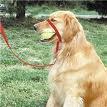
When showing progress inside with excessive barking, take it outside. Outside there is even more reasons to bark! Or so the dog thinks. You must claim these situations by using the same techniques as previously stated in the other barking blogs except always have a leash on the dog and make sure you practice daily in controlled situations. Like asking the neighbor to come by or the neighbor’s dog. Whatever is the trigger for your dog’s barking. 5 minutes a day.
You can also purchase a Gentle Leader. This way you can close his mouth and redirect his head. Make sure the halter is put on the dog properly so he doesn’t fear it. He must be comfortable with it so be patient and put it on slowly. Then give him a treat. Then take it off and put it on again…treat. You get it! It’s just until he is comfortable with it. Of course if he is comfortable from the get-go then no need for this. If he seems to despise it, take your time and a deep breathe. Try putting his favorite treat, maybe a hot dog through the loop of the leader, and have him get the treat by putting his head through it on his own.

If used properly a Gentle Leader is a good training tool
When Fido barks at someone you lift the leash up so his mouth closes-gently and he will sit. Then move again, forward or just elsewhere so you stop him from focusing on what made him bark and we get his attention on us. Make sure the leash becomes loose immediately after this correction. That way, he recognizes it as a correction. If you don’t loosen the lead, he won’t make the distinction-even if you must correct him again immediately, it must loosen as quickly as making the correction took. Make sure you use the lead gently. If you correct out of frustration, you could close his mouth too harshly and he will learn to be afraid of it.
Calm and Confident!
You can also redirect with food. Learn the ‘watch me’ command inside the house and then try it outside. Use it when he is focused on whatever sets him off.
If you are still having trouble consult an expert in behavioral issues. Do your homework and know their methods to make sure you agree with them. There are many-many approaches to training dogs, so make sure you are comfortable with the trainer or you won’t be confident in repeating those methods with your pet.
Teaching them the speak/quiet command can also greatly help.
Above all, make sure you exercise your dog before practicing these techniques, and especially before you leave for work. Leave things for your dog to do when you leave, like a Kong filled with peanut butter, a plastic ball that lets out his food when rolled around, and a couple of toys.
